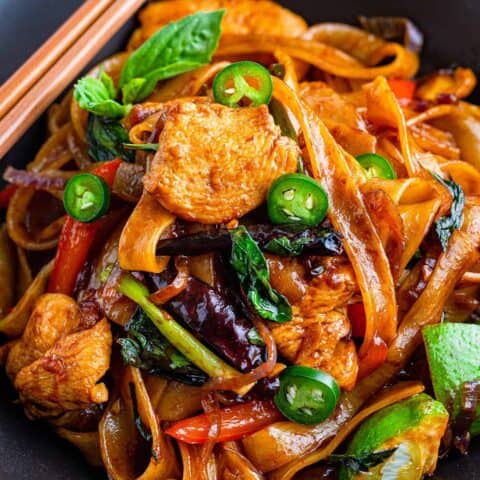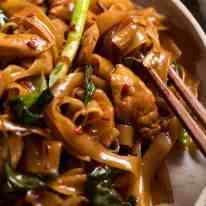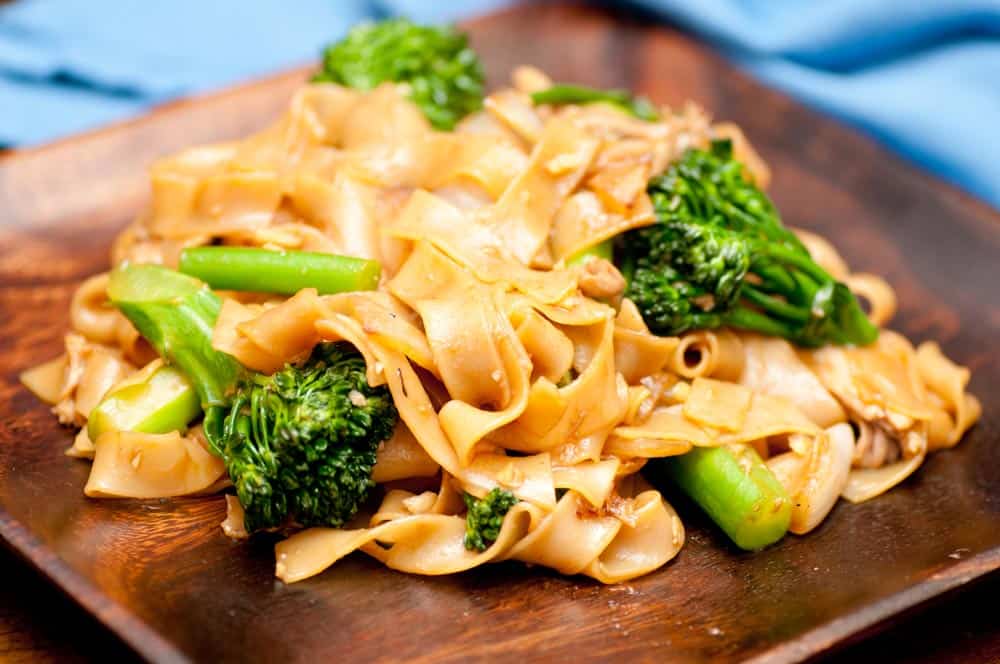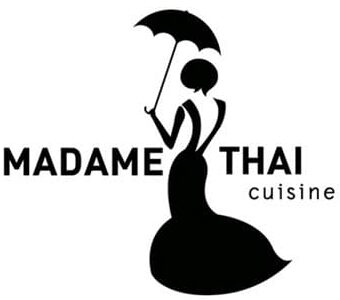Origins And Ingredients

Drunken Noodles, also known as Pad Kee Mao, originated in Thailand and is commonly enjoyed as a spicy street food. It typically consists of wide rice noodles stir-fried with a medley of fresh vegetables, meat or seafood, and a bold mixture of Thai basil, chilies, garlic, and soy sauce. On the other hand, Pad Thai is a famous noodle dish that gained popularity during World War II. It features thin rice noodles stir-fried with eggs, tofu or shrimp, bean sprouts, crushed peanuts, and a tangy sauce made from tamarind paste, fish sauce, and palm sugar.
Pad Thai: Origin And Key Ingredients
Pad Thai is a beloved Thai dish that originated during World War II. It was created as part of a government campaign to promote the use of local ingredients and foster national identity. The dish typically consists of thin rice noodles stir-fried with eggs, tofu or shrimp, bean sprouts, and crushed peanuts. The key ingredients in Pad Thai include tamarind paste, fish sauce, and palm sugar, which give it a unique sweet, sour, and savory flavor. This combination of ingredients results in a delicious and satisfying dish that has become a global favorite.
Drunken Noodles: History And Essential Components
Drunken Noodles, also known as Pad Kee Mao, is a popular Thai street food dish with a fascinating history. Despite its name, the noodles are not actually cooked with alcohol. The dish’s name is believed to have originated from the idea that it is a perfect late-night meal for those who have had a few drinks.
Drunken Noodles are typically made with wide rice noodles stir-fried with a combination of fresh vegetables, meat (such as chicken, pork, or beef), and aromatic herbs and spices. The key ingredients in this dish include oyster sauce, soy sauce, garlic, chili peppers, and Thai basil. These components create a rich, savory, and slightly spicy flavor profile that makes Drunken Noodles a beloved favorite among Thai food enthusiasts.
Cooking Methods And Flavor Profiles

Pad Thai and Drunken Noodles have distinctive cooking methods that contribute to their unique flavor profiles. Pad Thai is typically stir-fried, starting with frying the aromatics, followed by adding the protein, noodles, and sauce. This method creates a balanced combination of sweet, sour, and savory flavors. Drunken Noodles, on the other hand, are cooked using a high heat stir-frying technique, resulting in slightly charred noodles. This method imparts a smoky flavor and enhances the overall spiciness of the dish. Both dishes offer a delightful blend of flavors that are sure to satisfy any Thai food lover.
Pad Thai: Traditional Preparation And Taste Profile
Pad Thai is traditionally prepared by stir-frying thin rice noodles with a variety of ingredients. The cooking process begins with frying aromatics such as garlic and shallots in oil, followed by adding proteins like shrimp or chicken. Next, the noodles are added and cooked until they are soft and infused with flavors from the sauce. The sauce, made with ingredients like tamarind paste, fish sauce, and palm sugar, gives Pad Thai its signature sweet, sour, and savory taste. It is garnished with bean sprouts, chopped peanuts, and lime wedges for added freshness and crunch. Overall, Pad Thai offers a harmonious balance of flavors that is both satisfying and delicious.
Drunken Noodles: Cooking Techniques And Flavor Characteristics
Drunken Noodles, also known as Pad Kee Mao, are typically prepared by stir-frying the wide rice noodles with a combination of ingredients that create a bold and spicy flavor profile. The cooking process involves quickly cooking the noodles in a hot wok or skillet, along with vegetables, meats, and a Thai basil sauce. The intense heat and quick cooking time help to maintain the noodles’ chewy texture while allowing the flavors to develop. The dish is known for its spicy and savory taste, often infused with garlic, chili, soy sauce, and fish sauce. The result is a satisfying and aromatic noodle dish with a spicy kick.
Popular Variations And Customizations

Pad Thai: Regional variations and popular add-ins
Pad Thai is a versatile dish that can be customized and adapted to suit individual preferences and regional variations. Some common variations include:
- Protein options: While traditional Pad Thai typically includes shrimp, variations may feature chicken, tofu, or even a combination of different proteins.
- Vegetable variations: Some versions of Pad Thai may incorporate additional vegetables such as bean sprouts, broccoli, bell peppers, or mushrooms.
- Customized spice levels: The level of spiciness can be adjusted according to personal taste, with some opting for a milder flavor while others prefer a fiery kick.
- Toppings and garnishes: Popular additions to Pad Thai include crushed peanuts, lime wedges, cilantro, and scallions, which add texture and freshness to the dish.
Drunken Noodles: Customization options and common adaptations
Drunken Noodles also offer various customization options to cater to different palates and preferences. Here are some popular adaptations:
- Protein choices: Similar to Pad Thai, Drunken Noodles can be made with different proteins like chicken, beef, or seafood, depending on personal preference.
- Vegetable variations: Additional vegetables such as bell peppers, onions, carrots, or broccoli can be added to enhance the nutritional value and texture of the dish.
- Heat levels: The spiciness of Drunken Noodles can be adjusted by increasing or reducing the amount of chili peppers or hot sauce used, allowing individuals to enjoy the dish at their desired heat level.
- Sauce variations: While the traditional Thai basil sauce is used in Drunken Noodles, some variations may incorporate other sauces like oyster sauce or soy sauce for a different flavor profile.
By customizing these dishes, individuals can create their own unique versions of Pad Thai and Drunken Noodles, tailoring them to their taste preferences and dietary needs.
Pad Thai: Regional Variations And Popular Add-ins
There are various regional variations of Pad Thai that offer unique twists on the classic dish. In some regions of Thailand, additional ingredients like dried shrimp, pickled radish, or preserved turnips may be added for added flavor. In the south, Pad Thai is often served with a side of fresh herbs, including Thai basil and bean sprouts. Some variations also include ingredients like Chinese chives, tofu, or even banana blossoms. Popular add-ins to enhance the flavors and textures of Pad Thai include crushed peanuts, lime wedges, cilantro, and scallions. These customizations allow individuals to personalize their Pad Thai experience according to their tastes and preferences.
Drunken Noodles: Customization Options And Common Adaptations
Drunken Noodles offer a wide range of customization options to suit individual tastes. Common adaptations include varying the protein, such as using chicken, beef, or even seafood instead of the traditional pork. Vegetarians can substitute tofu or tempeh. Additional vegetables like bell peppers, broccoli, or bok choy can be added for extra crunch and nutrition. For spice lovers, adding extra chili peppers or chili flakes can elevate the heat level. Lime juice can be squeezed over the noodles for a tangy twist, and garnishes like cilantro and Thai basil add freshness and aroma. The beauty of Drunken Noodles lies in its versatility, allowing for endless possibilities to create a personalized and flavorful dish.
Nutritional Comparison

When it comes to the nutritional content, Pad Thai and Drunken Noodles have some differences worth considering. Pad Thai typically contains fewer calories and less fat compared to Drunken Noodles. However, Drunken Noodles often have a higher protein content due to the use of meat or seafood as a main ingredient. Both dishes provide carbohydrates from the noodles, and their nutrient profiles can be enhanced by adding vegetables and garnishes. It’s important to note that specific nutritional values may vary depending on the recipe and cooking methods used.
Pad Thai: Nutritional Content And Health Benefits
Pad Thai is a flavorful dish that offers a range of nutritional benefits. It typically contains fewer calories and less fat compared to Drunken Noodles, making it a lighter option. Pad Thai also provides a good source of carbohydrates from the noodles, which can provide energy. Additionally, Pad Thai often includes vegetables and garnishes, which add essential vitamins and minerals to the dish. Overall, Pad Thai can be a healthy choice, especially when made with lean proteins such as shrimp or tofu and plenty of vegetables. However, it’s important to be mindful of portion sizes and the use of high-sodium sauces.
Drunken Noodles: Nutrient Profile And Dietary Considerations
Drunken Noodles offer a range of nutrients that contribute to a healthy diet. While the exact nutrient profile may vary depending on the specific ingredients used, this dish typically contains a good amount of protein from the choice of meat or tofu. The wide rice noodles provide carbohydrates for energy, and the addition of vegetables adds essential vitamins and minerals. However, it’s important to note that Drunken Noodles can be higher in sodium due to the seasoning sauces used. To make it a healthier option, opt for lean proteins, use less sodium, and incorporate a variety of colorful vegetables.
Serving And Pairing Suggestions

When it comes to serving Pad Thai, it is best enjoyed hot and fresh. Garnish with crushed peanuts, lime wedges, and freshly chopped cilantro for added flavor and presentation. Pair it with a side of Thai iced tea or a refreshing cucumber salad to balance out the richness of the dish.
For Drunken Noodles, serve them hot straight from the wok. Consider adding a sprinkle of fresh Thai basil leaves and a squeeze of lime to enhance the flavors. Drunken Noodles go well with a side of crunchy spring rolls or a tangy papaya salad. For beverages, try pairing them with a cold glass of Thai iced coffee or a light lager beer for a satisfying combination.
Pad Thai: Best Serving Practices And Ideal Pairings
When it comes to serving Pad Thai, it is best enjoyed hot and fresh. Garnish with crushed peanuts, lime wedges, and freshly chopped cilantro for added flavor and presentation. Pair it with a side of Thai iced tea or a refreshing cucumber salad to balance out the richness of the dish. The combination of the nutty, tangy, and sweet flavors of Pad Thai with the cool and crisp accompaniments creates a delightful culinary experience.
Drunken Noodles: Serving Recommendations And Beverage Pairings
When it comes to serving Drunken Noodles, it is best to serve them piping hot to fully enjoy their bold flavors. These savory noodles can be garnished with fresh herbs like basil or cilantro for an added burst of freshness. To complement the spiciness of Drunken Noodles, consider pairing them with a refreshing beverage like Thai iced tea or a crisp lager beer. The sweetness of the tea or the lightness of the beer can help balance out the heat and enhance the overall dining experience.
Conclusion

In conclusion, while both Pad Thai and Drunken Noodles are beloved Thai noodle dishes, they offer distinct flavors, preparation methods, and customization options. Pad Thai is known for its tangy and slightly sweet taste, while Drunken Noodles provide a bolder and spicier flavor profile. It ultimately comes down to personal preference and the specific flavors you’re craving. Whether you prefer the classic combination of peanuts and lime in Pad Thai or the fiery heat of Drunken Noodles, both dishes offer a delightful culinary experience that showcases the rich and diverse cuisine of Thailand.
Summary Of Differences Between Pad Thai And Drunken Noodles
Pad Thai and Drunken Noodles may both be delicious Thai noodle dishes, but they have distinct differences. Pad Thai offers a nuttier and sweeter flavor profile, with tangy and slightly sweet notes. On the other hand, Drunken Noodles are known for their spicy and savory taste, with bolder and spicier flavors. The ingredients used in each dish also differ, with Pad Thai typically including tamarind paste and peanuts, while Drunken Noodles feature ingredients like Thai basil and Thai chili. These variations in taste and components make Pad Thai and Drunken Noodles unique and offer diverse culinary experiences.
Personal Preference And Final Thoughts
When it comes to choosing between Pad Thai and Drunken Noodles, personal preference plays a significant role. Some individuals may prefer the nuttier and sweeter flavors of Pad Thai, while others may favor the bold and spicy taste of Drunken Noodles. It ultimately depends on one’s preference for savory or sweet dishes and their tolerance for spiciness. Both dishes offer unique culinary experiences and are beloved by Thai food enthusiasts. So, whether you’re a fan of Pad Thai or Drunken Noodles, you’re sure to enjoy the rich flavors and tantalizing spices that these dishes have to offer.
FAQ About Pad Thai Vs Drunken Noodles: Comparing Popular Thai Noodle Dishes
Q: What is the main difference between Pad Thai and Drunken Noodles?
A: The main difference lies in the noodles used. Pad Thai utilizes rice noodles, while Drunken Noodles are made with wide rice noodles.
Q: How do Pad Thai and Drunken Noodles differ in flavor?
A: Pad Thai is typically sweet and sour, with flavors of tamarind, fish sauce, and peanuts. Drunken Noodles, on the other hand, are savory and spicy, often featuring basil, chili, and soy sauce.
Q: Which dish is spicier – Pad Thai or Drunken Noodles?
A: Drunken Noodles are generally spicier than Pad Thai due to the addition of chili peppers and other spicy ingredients.
Q: Can Pad Thai and Drunken Noodles be customized to suit dietary preferences?
A: Yes, both dishes can be customized to accommodate various dietary preferences, including vegetarian, vegan, gluten-free, and protein choices such as tofu, chicken, shrimp, or beef.
Q: Are Pad Thai and Drunken Noodles equally popular in Thai cuisine?
A: While both Pad Thai and Drunken Noodles are popular Thai noodle dishes, Pad Thai is more widely recognized internationally, whereas Drunken Noodles are a favorite among locals in Thailand for its bold flavors.
Q: Which dish is considered healthier – Pad Thai or Drunken Noodles?
A: In terms of healthiness, Pad Thai is often perceived as a lighter option as it contains fewer calories and less fat compared to Drunken Noodles, which can be higher in oil content and spicier ingredients.

Madame Thai Cuisine is not just a restaurant; it’s a culinary journey through Thailand’s vibrant and diverse flavors. Our story began with a passion for sharing the authentic tastes of Thailand with the world. Situated in the heart of [location], Madame Thai Cuisine has been a beacon of Thai culinary excellence since [year of establishment]. Our commitment to using only the finest and freshest ingredients, combined with traditional cooking techniques, has earned us a reputation as a go-to destination for exquisite Thai dining.